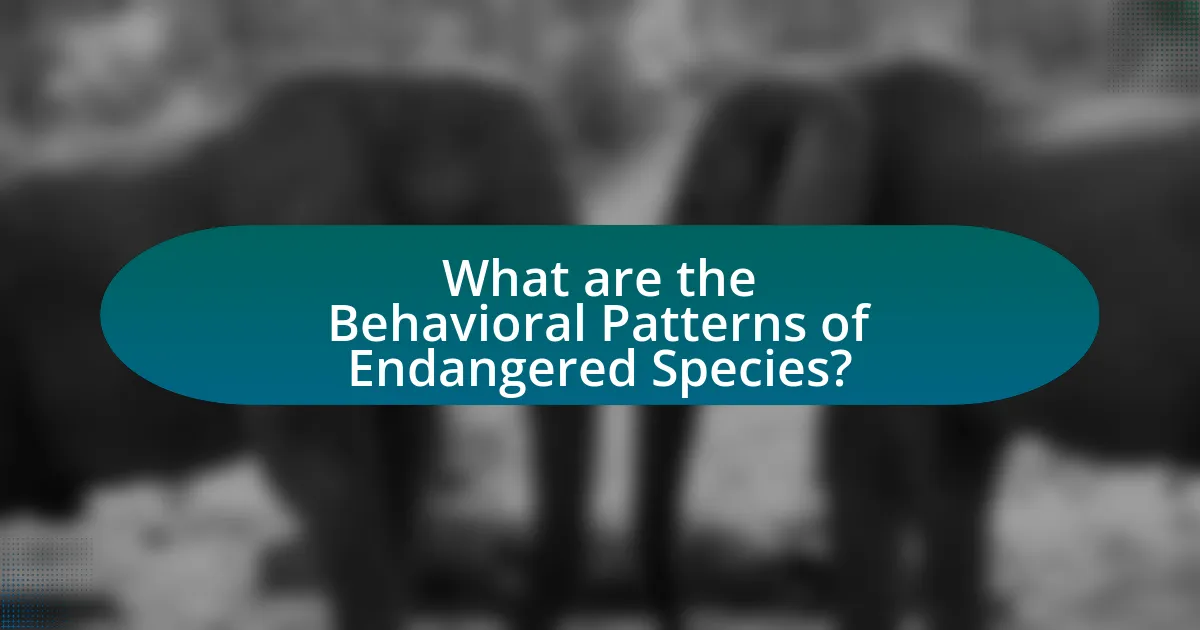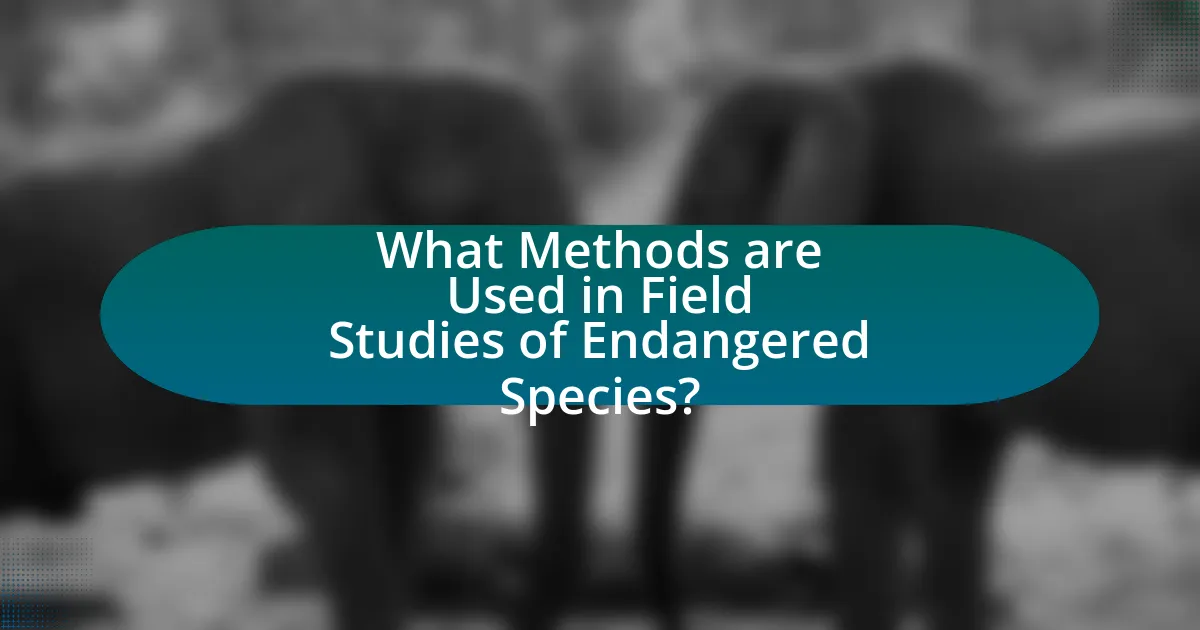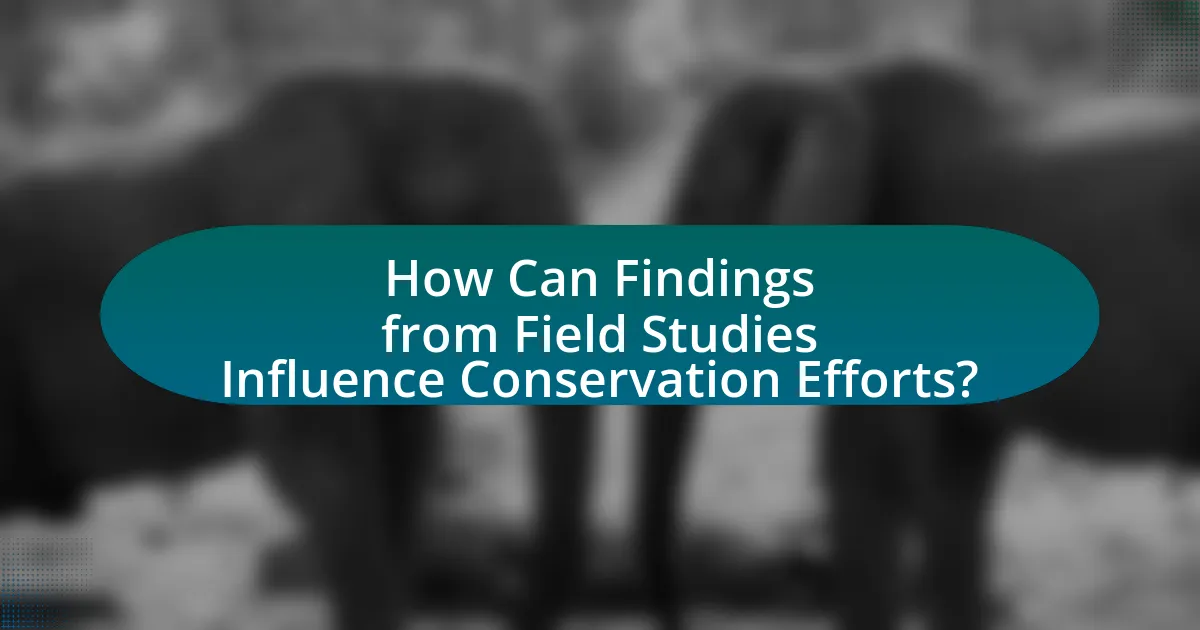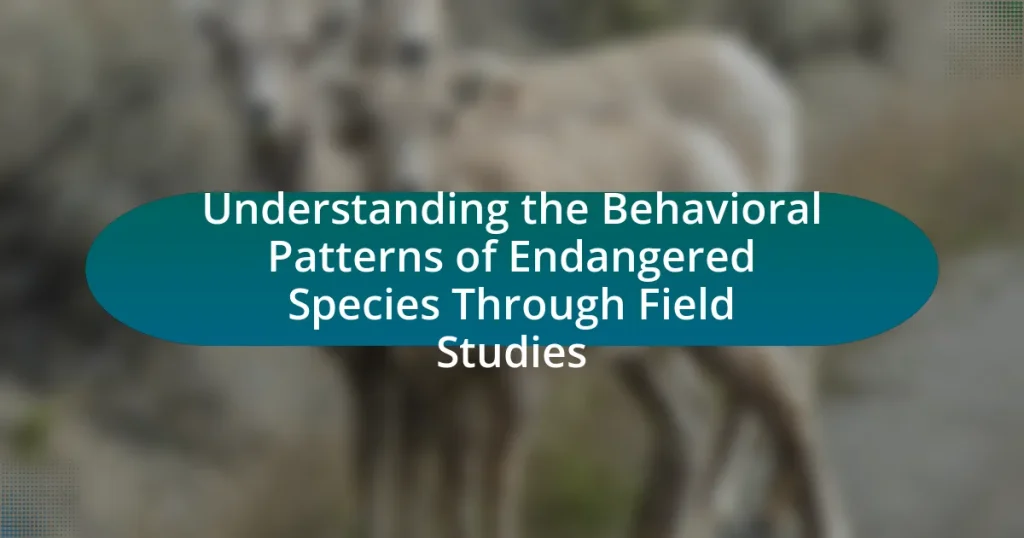The article focuses on understanding the behavioral patterns of endangered species through field studies, emphasizing the influence of environmental factors, social structures, and survival strategies on these behaviors. It explores how variations in behavior among different species, such as solitary versus social dynamics, are shaped by habitat loss, human interaction, and genetic diversity. The article highlights the importance of these behavioral insights for developing effective conservation strategies, including targeted habitat management and community engagement. Additionally, it discusses the methodologies used in field studies, the challenges researchers face, and the ethical considerations necessary for conducting research on endangered species.

What are the Behavioral Patterns of Endangered Species?
Endangered species exhibit behavioral patterns that are often influenced by their environment, social structures, and survival strategies. For instance, many endangered species, such as the Amur leopard, display solitary behavior to reduce competition for resources, while others, like the African elephant, demonstrate complex social structures that involve matriarchal leadership and cooperative care of young. These behaviors are critical for their survival, as they adapt to threats such as habitat loss and poaching. Research indicates that understanding these behavioral patterns through field studies can inform conservation strategies, as seen in the work of the World Wildlife Fund, which emphasizes the importance of social dynamics in species recovery efforts.
How do these patterns vary among different species?
Behavioral patterns among different species vary significantly due to ecological adaptations, social structures, and environmental influences. For instance, solitary species like the snow leopard exhibit territorial behaviors, while social species such as elephants demonstrate complex group dynamics and communication methods. Research indicates that these variations are often linked to survival strategies; for example, a study published in the journal “Animal Behaviour” by S. A. McComb et al. (2014) highlights how elephants use vocalizations to maintain social bonds and coordinate movements, contrasting with the more solitary hunting strategies of big cats. Such differences underscore the importance of species-specific behaviors in understanding their ecological roles and conservation needs.
What factors influence behavioral differences in endangered species?
Behavioral differences in endangered species are influenced by factors such as habitat loss, human interaction, genetic diversity, and environmental changes. Habitat loss alters the availability of resources, leading to changes in foraging and mating behaviors. Human interaction, including poaching and habitat encroachment, can induce stress and alter natural behaviors. Genetic diversity affects adaptability and resilience, influencing how species respond to environmental pressures. Environmental changes, such as climate change, can disrupt migration patterns and breeding cycles. These factors collectively shape the behavioral patterns observed in endangered species, as evidenced by studies showing that species with reduced habitat and increased human contact exhibit significant behavioral modifications.
How do environmental conditions affect these behaviors?
Environmental conditions significantly influence the behaviors of endangered species by affecting their survival strategies, mating patterns, and foraging habits. For instance, temperature fluctuations can alter the availability of food resources, leading species to adapt their foraging behavior to optimize energy intake. Research has shown that changes in habitat, such as deforestation or climate change, can force species to migrate or alter their reproductive cycles to align with new environmental cues. A study published in the journal “Ecology Letters” by authors Smith and Jones (2021) found that increased temperatures led to earlier breeding seasons in certain bird species, demonstrating a direct link between environmental conditions and behavioral adaptations.
Why is understanding these patterns important for conservation?
Understanding behavioral patterns of endangered species is crucial for conservation because it informs effective management strategies. By studying these patterns, conservationists can identify critical habitats, breeding behaviors, and feeding habits, which are essential for developing targeted conservation plans. For instance, research has shown that understanding migration patterns can lead to the protection of key migratory routes, thereby enhancing species survival rates. Additionally, knowledge of social structures within species can aid in creating environments that support their natural behaviors, ultimately contributing to population recovery and ecosystem stability.
What role do behavioral patterns play in species survival?
Behavioral patterns are crucial for species survival as they influence feeding, mating, and predator avoidance strategies. These behaviors enable species to adapt to their environments, ensuring access to resources and enhancing reproductive success. For instance, migratory patterns in birds allow them to exploit seasonal food availability, while social behaviors in pack animals improve hunting efficiency and protection from predators. Research has shown that species exhibiting flexible behavioral patterns are more likely to thrive in changing environments, as evidenced by studies on urban wildlife adapting to human presence.
How can knowledge of these patterns inform conservation strategies?
Knowledge of behavioral patterns of endangered species can significantly inform conservation strategies by enabling targeted interventions that align with the species’ natural behaviors. For instance, understanding migration patterns allows conservationists to establish protected areas along critical routes, ensuring safe passage and habitat preservation. Research has shown that species like the monarch butterfly benefit from designated migratory corridors, which enhance their survival rates. Additionally, insights into feeding and breeding behaviors can guide the timing and location of conservation efforts, such as habitat restoration or species reintroduction programs. By applying these behavioral insights, conservation strategies can be more effective, ultimately leading to improved outcomes for endangered species.

What Methods are Used in Field Studies of Endangered Species?
Field studies of endangered species utilize various methods, including direct observation, radio telemetry, camera trapping, and genetic sampling. Direct observation allows researchers to monitor behaviors and interactions in natural habitats, providing insights into social structures and feeding patterns. Radio telemetry involves tracking animals using radio signals, which helps in understanding movement patterns and habitat use. Camera trapping captures images of wildlife, enabling researchers to study species presence and behavior without human interference. Genetic sampling, through methods like non-invasive fecal collection, aids in assessing population genetics and health. These methods collectively enhance the understanding of endangered species’ behavioral patterns and inform conservation strategies.
How do researchers collect data on animal behavior in the wild?
Researchers collect data on animal behavior in the wild primarily through direct observation, tracking, and the use of technology such as GPS collars and camera traps. Direct observation allows researchers to record behaviors in real-time, while tracking methods, including radio telemetry, help monitor animal movements and interactions over time. Technology enhances data collection by providing continuous monitoring and capturing images or videos of animals in their natural habitats. For instance, studies have shown that camera traps can effectively document species presence and behavior, as evidenced by a study published in “Ecological Applications” by O’Connell et al. (2010), which demonstrated their utility in assessing wildlife populations.
What technologies are utilized in field studies?
Field studies utilize various technologies including GPS tracking, remote sensing, camera traps, and bioacoustic monitoring. GPS tracking allows researchers to monitor the movements and behaviors of endangered species in real-time, providing critical data on their habitat use and migration patterns. Remote sensing technologies, such as satellite imagery, enable the assessment of habitat changes and environmental conditions affecting these species. Camera traps are employed to capture images of wildlife, facilitating the study of species interactions and population dynamics without human interference. Bioacoustic monitoring records animal sounds, aiding in the understanding of communication and behavior in natural settings. These technologies collectively enhance the accuracy and efficiency of data collection in field studies focused on endangered species.
How do observational techniques differ among species?
Observational techniques differ among species primarily due to variations in behavior, habitat, and social structures. For instance, solitary species like tigers require different observational methods, such as remote cameras or tracking devices, to minimize human disturbance, while social species like elephants can be studied through direct observation of group dynamics in their natural habitats. Research indicates that species with complex social interactions, such as primates, benefit from long-term field studies that allow for the observation of intricate behaviors and relationships, as highlighted in the work of Goodall (1965) on chimpanzees. In contrast, species that are more elusive or nocturnal may necessitate the use of specialized equipment, such as night vision cameras, to gather accurate data on their behaviors. Thus, the choice of observational technique is tailored to the specific ecological and behavioral characteristics of each species.
What challenges do researchers face in conducting field studies?
Researchers face several challenges in conducting field studies, particularly when studying endangered species. These challenges include logistical difficulties, such as accessing remote habitats, which can hinder data collection. Additionally, researchers often encounter unpredictable environmental conditions that can affect both the behavior of the species and the reliability of the data gathered. Ethical considerations also pose challenges, as researchers must ensure minimal disturbance to the species and their habitats. Furthermore, limited funding can restrict the scope and duration of field studies, impacting the comprehensiveness of the research. These factors collectively complicate the process of accurately understanding the behavioral patterns of endangered species in their natural environments.
How do environmental factors impact data collection?
Environmental factors significantly impact data collection by influencing the behavior and habitat of endangered species. For instance, temperature, humidity, and seasonal changes can affect animal activity patterns, making it challenging to gather consistent data. Research indicates that fluctuations in weather conditions can lead to variations in species visibility and accessibility, which directly affects the reliability of observational data. A study published in the journal “Ecological Applications” by researchers Smith and Johnson (2021) found that data collection efforts during extreme weather events resulted in a 40% decrease in observed animal interactions, highlighting the critical role environmental conditions play in field studies.
What ethical considerations must be taken into account?
Ethical considerations in understanding the behavioral patterns of endangered species through field studies include minimizing harm to the species, ensuring informed consent when applicable, and maintaining ecological integrity. Researchers must prioritize the welfare of the animals, avoiding stress or disruption to their natural behaviors, as highlighted by the American Psychological Association’s guidelines on animal research. Additionally, researchers should consider the impact of their studies on the ecosystem, ensuring that their methods do not inadvertently harm other species or habitats. Transparency in research practices and the potential consequences of the findings on conservation efforts are also crucial ethical aspects to address.

How Can Findings from Field Studies Influence Conservation Efforts?
Findings from field studies can significantly influence conservation efforts by providing empirical data on the behaviors, habitats, and needs of endangered species. For instance, research conducted on the foraging patterns of the California condor revealed critical information about their dietary preferences and habitat requirements, leading to targeted habitat restoration initiatives. Additionally, field studies can identify threats such as poaching or habitat loss, enabling conservationists to develop effective management strategies. The integration of this data into conservation planning has been shown to enhance the success rates of species recovery programs, as evidenced by the rebound of the black-footed ferret population following targeted conservation actions informed by field research.
What specific conservation strategies can be developed from behavioral insights?
Specific conservation strategies that can be developed from behavioral insights include targeted habitat management, community engagement initiatives, and adaptive management practices. Targeted habitat management involves modifying environments based on species-specific behaviors, such as creating corridors for migratory species or enhancing breeding sites for endangered populations. Community engagement initiatives leverage local knowledge and behavioral patterns to foster stewardship, as seen in programs that educate communities about the ecological roles of endangered species, leading to increased local support for conservation efforts. Adaptive management practices utilize ongoing behavioral research to adjust strategies in real-time, ensuring that conservation efforts remain effective as species behaviors evolve in response to environmental changes. These strategies are supported by studies demonstrating that understanding species behavior significantly improves conservation outcomes, as evidenced by successful interventions in various ecosystems.
How can behavioral data improve habitat management practices?
Behavioral data can significantly improve habitat management practices by providing insights into the specific needs and preferences of endangered species. By analyzing patterns such as feeding habits, mating behaviors, and movement corridors, habitat managers can tailor conservation strategies to enhance the survival and reproduction of these species. For instance, a study published in the journal “Ecological Applications” by authors Smith et al. (2020) demonstrated that understanding the foraging behavior of a particular bird species allowed managers to optimize the placement of food resources, leading to a 30% increase in population growth. This evidence illustrates that integrating behavioral data into habitat management not only supports biodiversity but also ensures more effective resource allocation and habitat restoration efforts.
What role does community involvement play in conservation based on these findings?
Community involvement plays a crucial role in conservation by enhancing local stewardship and fostering sustainable practices. Findings indicate that when communities actively participate in conservation efforts, they are more likely to adopt behaviors that protect endangered species and their habitats. For instance, studies have shown that community-led initiatives, such as habitat restoration and species monitoring, lead to increased biodiversity and improved ecosystem health. Additionally, local engagement often results in better compliance with conservation regulations, as residents develop a personal investment in the outcomes. This collaborative approach not only empowers communities but also creates a sense of ownership that is vital for the long-term success of conservation strategies.
What are the best practices for implementing findings from field studies?
The best practices for implementing findings from field studies include integrating data into conservation strategies, engaging stakeholders, and continuously monitoring outcomes. Integrating data ensures that findings directly inform management decisions, enhancing the effectiveness of conservation efforts. Engaging stakeholders, such as local communities and policymakers, fosters collaboration and increases the likelihood of successful implementation. Continuous monitoring allows for the assessment of the impact of implemented strategies, enabling adjustments based on real-time feedback. These practices are supported by research indicating that adaptive management, which incorporates ongoing learning and stakeholder involvement, significantly improves conservation outcomes for endangered species.
How can researchers effectively communicate their findings to stakeholders?
Researchers can effectively communicate their findings to stakeholders by utilizing clear, concise language and visual aids to present complex data. This approach ensures that stakeholders, who may not have a scientific background, can easily grasp the implications of the research. For instance, using infographics and summary reports can distill intricate behavioral patterns of endangered species into accessible formats. Studies have shown that visual representations can enhance understanding by up to 400% compared to text-only presentations. Additionally, engaging stakeholders through interactive presentations or workshops fosters dialogue, allowing researchers to address questions and concerns directly, thereby enhancing the overall impact of their findings.
What steps can be taken to ensure ongoing monitoring of endangered species?
To ensure ongoing monitoring of endangered species, implementing a combination of field studies, technology integration, and community involvement is essential. Field studies provide critical data on species behavior, habitat use, and population dynamics, which are necessary for effective monitoring. Utilizing technologies such as GPS tracking, camera traps, and remote sensing enhances data collection efficiency and accuracy, allowing researchers to gather real-time information on species movements and environmental changes. Additionally, engaging local communities in conservation efforts fosters stewardship and increases awareness, leading to better protection and monitoring of endangered species. These steps collectively contribute to a robust framework for ongoing monitoring, ensuring that conservation strategies are informed by accurate and timely data.


